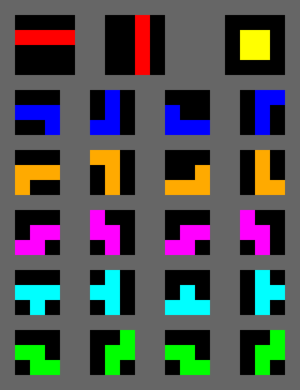Sega Rotation: Difference between revisions
No edit summary |
No edit summary |
||
| Line 1: | Line 1: | ||
[[Image:ARS-pieces.png|thumb|All rotation states of all seven tetrominoes. From top to bottom: I, J, L, S, T, Z. Top right: O.]] | |||
'''Sega rotation''' is a [[rotation system]] that has been used by [[Sega Tetris|Sega's arcade version of ''Tetris'']] and its successors. | '''Sega rotation''' is a [[rotation system]] that has been used by [[Sega Tetris|Sega's arcade version of ''Tetris'']] and its successors. | ||
== Basic rotation == | |||
Tetrominoes start out centered, rounding to the left. I goes in columns 3–6 counting from the left, O in columns 4–5, and others in columns 4–6. Each tetromino starts with its topmost solid block in row 20 (or 22 in ''TGM ACE''). | |||
Each tetromino is ordinarily spawned flat side up. There is no initial rotation, and no wallkicks. Additionally, the ceiling prevents rotation. | |||
Apart from I and O, all tetrominoes rotate such that the bottom of the tetromino is at the bottom of the piece's bounding box. S and Z rotate between two states so that the center column stays constant. O does not rotate; I rotates between two states as depicted in the illustration. | |||
The differences between Sega rotation and [[Nintendo Rotation System]] are that the flat-side-down states of J, L, and T are pushed down by one space, that S and Z round in different directions, that I rounds differently from the other pieces, and that I requires more space under it to rotate to a vertical orientation. | |||
Sega rotation originally used no [[wall kick]]s. [[Arika]] took Sega rotation, added mild wall kicks and initial rotation, and ended up with [[TGM Rotation]], or Arika Rotation System. In addition to the TGM series, most arcade games developed in Japan before the guideline followed the Sega rotation rules with varying degrees of wall kicks, such as [[Flash Point]], [[Bloxeed]], [[Sega Tetris]], and the [[Tetris Plus]] series. | |||
== Colors == | == Colors == | ||
| Line 48: | Line 61: | ||
</playfield> | </playfield> | ||
|} | |} | ||
== Games == | == Games == | ||
| Line 68: | Line 69: | ||
*[[Tetris Plus]] | *[[Tetris Plus]] | ||
*[[Tetris Plus 2]] | *[[Tetris Plus 2]] | ||
*[[Tetris The GrandMaster Series]] | |||
*[[Tetris 64]] (with Rotation Center off) | *[[Tetris 64]] (with Rotation Center off) | ||
*[[Sega Tetris]] | *[[Sega Tetris]] | ||
| Line 73: | Line 75: | ||
== See also == | == See also == | ||
*[[Arika Rotation System]] | *[[Arika Rotation System]] | ||
== References == | == References == | ||
*[http://www13.plala.or.jp/TETRiS_TGM/kouza/index.htm TGM rotations, in Japanese] | *[http://www13.plala.or.jp/TETRiS_TGM/kouza/index.htm TGM rotations, in Japanese] | ||
{{Template:Sega games}} | |||
[[Category:Rotation Systems]] | [[Category:Rotation Systems]] | ||
Revision as of 05:55, 22 December 2018
Sega rotation is a rotation system that has been used by Sega's arcade version of Tetris and its successors.
Basic rotation
Tetrominoes start out centered, rounding to the left. I goes in columns 3–6 counting from the left, O in columns 4–5, and others in columns 4–6. Each tetromino starts with its topmost solid block in row 20 (or 22 in TGM ACE). Each tetromino is ordinarily spawned flat side up. There is no initial rotation, and no wallkicks. Additionally, the ceiling prevents rotation.
Apart from I and O, all tetrominoes rotate such that the bottom of the tetromino is at the bottom of the piece's bounding box. S and Z rotate between two states so that the center column stays constant. O does not rotate; I rotates between two states as depicted in the illustration.
The differences between Sega rotation and Nintendo Rotation System are that the flat-side-down states of J, L, and T are pushed down by one space, that S and Z round in different directions, that I rounds differently from the other pieces, and that I requires more space under it to rotate to a vertical orientation.
Sega rotation originally used no wall kicks. Arika took Sega rotation, added mild wall kicks and initial rotation, and ended up with TGM Rotation, or Arika Rotation System. In addition to the TGM series, most arcade games developed in Japan before the guideline followed the Sega rotation rules with varying degrees of wall kicks, such as Flash Point, Bloxeed, Sega Tetris, and the Tetris Plus series.
Colors
Games using TGM/Sega rotation generally uses the following color scheme:
| I: red |
| |
| J: blue |
| |
| L: orange |
| |
| O: yellow |
| |
| S: magenta |
| |
| T: cyan |
| |
| Z: green |
|
Games
The following games use Sega rotation as their basic rotation:
- Tetris (Sega)
- Flash Point
- Bloxeed
- Tetris Plus
- Tetris Plus 2
- Tetris The GrandMaster Series
- Tetris 64 (with Rotation Center off)
- Sega Tetris
See also
References
| |||||||||||
